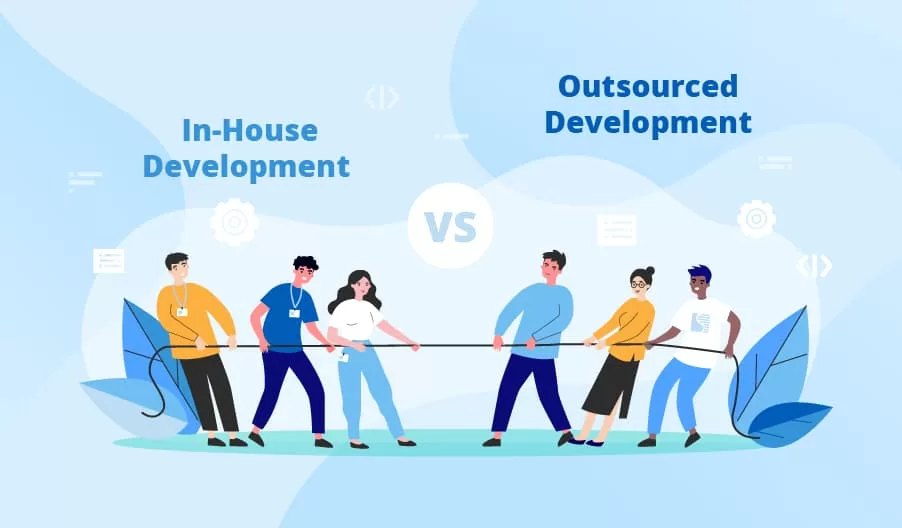In-House or Outsourced: 2025 Edition
A smart guide to software development choices for growing businesses.
- Outsourcing vs. In-House Software Development: What’s Right for Your Business in 2025?
- What Does In-House Software Development Really Mean?
- What About Outsourced Software Development?
- In-House vs. Outsourcing: A Detailed Comparison (2025 Perspective)
- Pros and Cons of In-House Software Development
- Pros and Cons of Outsourced Software Development
- When to Choose Outsourcing over In-house Development?
- Decision-Making Checklist
- Final Thoughts: What’s Right for Your Business?
- FAQs
Outsourcing vs. In-House Software Development: What’s Right for Your Business in 2025?
It's 2025. AI is everywhere, customer expectations are sky-high, and speed-to-market can make or break a business. Whether you’re a startup launching your first product or an enterprise improving internal systems, building scalable and secure software is no longer optional; it’s essential.
At Tech Formation, we’ve seen this shift firsthand. Businesses are investing more than ever in digital transformation, but they’re also facing a question:
Should you outsource software development or build an in-house team?
This decision can reshape your budget, team structure, delivery timelines, and ultimately, your competitive edge. In this guide, backed by our 15+ years of experience as a software development outsourcing company, we’ll break down the pros, cons, and costs of both models, so you can make an informed, future-ready choice.

What Does In-House Software Development Really Mean?
In-house software development means hiring your team of developers, designers, testers, and project managers who work full-time for your organization. This team is fully integrated into your business operations, culture, and long-term goals.
Choose in-house software development if your situation involves:
- Long-term, evolving projects.
- Software as a core business function.
- Full control over product direction and intellectual property.
But in-house development isn’t cheap or fast. You’re dealing with recruitment cycles, training, salaries, benefits, and the ever-present risk of turnover. At Tech Formation, we’ve supported many clients who initially attempted to scale with internal teams before turning to software outsourcing companies for flexibility and faster results.

What About Outsourced Software Development?
Outsourced software development means partnering with an external company to handle part or all of your software project.
In 2025, outsourcing isn’t just about cost savings. It’s a smart growth strategy that gives you access to specialized skills, modern tech stacks, and agile delivery models without the hassle of building from scratch.
What it Brings:
- Ready-to-go developers, designers, and QA teams.
- Faster time-to-market, lower upfront costs.
- Scalable, flexible, and focused on delivery.
Modern software development outsourcing services are designed to align closely with business goals, making it easier to move from idea to impact fast.

In-House vs. Outsourcing: A Detailed Comparison
| Criteria | In-House Development | Outsourced Development |
|---|---|---|
| Cost | High (salaries, benefits, tools) | Lower (especially offshore software outsourcing) |
| Speed to Start | Slow (recruiting, onboarding takes time) | Fast (pre-built teams, ready to launch) |
| Scalability | Limited by hiring capacity | Highly scalable on-demand |
| Control | Full control | Shared control with vendor |
| Communication | Direct, real-time | May involve time zones and cultural gaps |
| Expertise & Tools | Depends on internal resources | Access to diverse, up-to-date skill sets |
| Security & Compliance | Easier to manage on-site | Requires strict vetting and NDAs |
| Maintenance & Support | In-house ownership | Can be covered via support contracts |
Pros and Cons of In-House Software Development
In-house development means your software is built and maintained by a dedicated team that works within your organization. It offers full control, but that control comes at a cost.
Pros of In-House Development
- Full Control & Oversight: You manage your team directly, decide project priorities, and foster your desired work culture; everything runs on your terms.
- Deep Product Familiarity: Internal developers become tightly integrated with your product over time, making them well-equipped to handle complex updates or pivots.
- Stronger Alignment with Vision: Your in-house team lives and breathes your brand. That shared sense of mission often leads to higher quality and ownership.
- Real-Time Collaboration: With close proximity (physically or virtually), in-house teams can solve problems faster and iterate quickly with fewer communication barriers.
Cons of In-House Development
- Higher Operational Costs: From recruitment and salaries to hardware and benefits, building a team in-house can be expensive, especially in high-demand tech markets.
- Talent Gaps & Hiring Delays: Sourcing top-tier developers is competitive in 2025. You might wait months to fill a critical role.
- Scaling Challenges: Need to scale quickly? That usually means more recruitment cycles, onboarding, and overhead, not ideal for time-sensitive projects.
- Risk of Turnover: When key employees leave, they often take institutional knowledge with them. Replacing them mid-project can delay timelines.
Pros and Cons of Outsourced Software Development
Outsourced development involves working with external specialists or companies to build or maintain your software. It offers flexibility and fast execution, but may require more structured communication.
Pros of Outsourced Development
- Faster Time-to-Market: Outsourced teams are often ready to hit the ground running. Unlike in-house hiring, external partners usually have the talent pool already in place.
- Cost Efficiency: Outsourcing helps reduce operational costs significantly. You pay for the expertise and time you need, nothing more.
- Scalable Teams: Business needs can change quickly. Outsourcing allows you to scale your development team up or down without long-term commitments.
- Access to Specialized Skills: Outsourced teams often bring a diverse talent pool that spans frontend frameworks, backend architectures, mobile development, AI, DevOps, and more.
- Focus on Core Business: By outsourcing software development, your internal team can focus on what they do best, whether it’s business strategy, marketing, customer engagement, or operations.
- Reduced HR Burden: Building an in-house team involves ongoing recruitment, performance management, and employee retention strategies. Outsourcing removes much of that burden.
- Global Perspective & Innovation: Working with international teams can introduce new workflows, tools, and ideas that your internal team may not have considered.
Cons of Outsourced Development
- Reduced Day-to-Day Oversight: You’re not managing the team directly, which means less visibility into daily progress.
- Time Zone Differences: Working with teams across different time zones can sometimes cause coordination delays.
- Data Security Concerns: Sharing sensitive business data with third parties always carries risk. It’s crucial to establish strong contracts, NDAs, and use secure systems to protect intellectual property.
- Onboarding & Ramp-Up Time: External teams need time to get up to speed with your systems, goals, and workflows.
Not Sure What Fits Your Project?
Choosing the wrong model can delay growth and inflate costs. Get expert input before you commit.

When to Choose Outsourcing over In-house Development?

While both models serve different needs, Outsourcing might be the right move if:
- You want to build an MVP and test the waters fast
- You lack tech talent locally
- Your in-house team is overloaded
- You’re experimenting with new tech (like AI/ML or blockchain)
- You’re trying to control costs without compromising quality
💡 Insider Tip: Many companies start with software outsourcing, then move in-house once the product finds traction. It’s not a one-or-the-other game.
Decision-Making Checklist ✅
Before you decide, ask yourself:
| Question | If YES → Consider |
|---|---|
| Is speed your top priority? | Outsourcing |
| Are you building your core product long-term? | In-House |
| Do you have a tight budget? | Outsourcing |
| Need full control over the team and tech stack? | In-House |
| Want to experiment or build a PoC quickly? | Outsourcing |
| Can’t find/hire talent fast enough? | Outsourcing |
Your Next Step Starts Here
Whether you're just starting out or scaling up, we'll walk the journey with you.

Final Thoughts: What’s Right for Your Business?
There’s no one-size-fits-all answer. Whether you go with in-house software development or partner with software outsourcing companies, the right model depends on your goals, timelines, and internal capabilities.
If software is at the heart of your business, building an internal team offers long-term control and alignment. But if speed, flexibility, or niche skills are your top priorities, outsourcing development software can get you there faster, with lower risk and cost.
At Tech Formation, we often help clients implement hybrid development models: strategy stays in-house while execution is outsourced to trusted partners like us. This gives you the best of both worlds: control, scalability, and speed.
No matter which path you choose, the key is to make sure it sets you up for where you want your business to go next.
FAQs
Outsourcing is generally more cost-effective, especially for short-term or one-off projects. You save on infrastructure, hiring, and operational costs.
Yes, if you choose reputable software outsourcing companies with strong data security policies, NDAs, and compliance protocols in place.
Look for a software development outsourcing company with proven experience, real client testimonials, case studies, and clear communication processes.
Absolutely. Many companies follow a hybrid model where critical tasks stay in-house and scalable tasks are outsourced.
Costs, talent retention, and scalability. If one key developer leaves mid-project, it can delay your entire timeline.
Unsure What Comes Next?
We'll help you find the clearest, smartest path forward.

Let’s Connect and Create Something Remarkable


